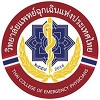ความสัมพันธ์ระหว่างอันตรกิริยาของยาอื่นกับวอร์ฟาริน และการมีค่าเวลาโปรทรอมบินเกินเป้าหมายการรักษาในแผนกฉุกเฉิน
คำสำคัญ:
วอร์ฟาริน, อันตรกิริยาระหว่างยา, ห้องฉุกเฉิน, ภาวะเลือดออกผิดปกติบทคัดย่อ
บทนำ วอร์ฟารินเป็นยาต้านการแข็งตัวของเลือดประเภทขัดขวางวิตามินเคซึ่งใช้อย่างแพร่หลายในการป้องกันและรักษาภาวะลิ่มเลือดอุดตัน ปัจจัยหลายอย่างทำให้ระดับไอเอ็นอาร์ (INR) เกินค่าเป้าหมายของการรักษา รวมถึงการได้รับยาที่มีอันตรกิริยาระหว่างยา ทำให้เกิดภาวะเลือดออกผิดปกติและเสียชีวิตได้
วัตถุประสงค์ ศึกษาความสัมพันธ์ของยาที่มีอันตรกิริยากับวอร์ฟารินต่อ INR เกินค่าเป้าหมายการรักษา รวมถึงความถี่ของการสั่งยาที่มีอันตรกิริยากับวอร์ฟาริน และภาวะเลือดออกผิดปกติ
วิธีการศึกษา การศึกษานี้เป็นการศึกษาตามแผนแบบย้อนหลัง (retrospective cohort) ทบทวนเวชระเบียนของผู้ป่วยที่มีอายุ 15 ปีขึ้นไป มีประวัติใช้ยาวอร์ฟารินมาตรวจที่แผนกฉุกเฉินและได้เจาะเลือดตรวจ ค่า INR จนกระทั่งจำหน่ายออกจากแผนกฉุกเฉินไป ตั้งแต่วันที่ 1 มกราคม พ.ศ. 2558 - 31 มิถุนายน พ.ศ. 2560
ผลการศึกษา ผู้ป่วยที่ใช้ยาวอร์ฟาริน เข้ารับการรักษาที่ห้องฉุกเฉิน 530 ครั้ง พบการสั่งยาที่มีอันตรกิริยาร่วมกับวอร์ฟาริน 378 ครั้ง (ร้อยละ 71.3) โดย มี INR เกินค่าเป้าหมาย 133 ครั้ง (ร้อยละ 25.1) ในผู้ป่วยกลุ่ม INR เกินค่าเป้าหมาย พบเลือดออกผิดปกติ 50 ครั้ง (ร้อยละ 37.6) โดยออกในทางเดินอาหารและในสมองร้อยละ 12 และ 5 ตามลำดับ การได้รับวอร์ฟารินร่วมกับยาที่มีอันตรกิริยามีความสัมพันธ์กับ INR เกินค่าเป้าหมายในผู้ป่วยที่รับยาที่มีความน่าจะเป็นสูงมากกว่า 1 ตัวขึ้นไป (อัตราส่วนออดส์ 2.60, ความเชื่อมั่นที่ร้อยละ 95: 1.27-5.32; ค่านัยสำคัญทางสถิติ = 0.01) และการได้รับวอร์ฟารินร่วมกับพาราเซตามอลและยาอื่นอีกชนิดที่มีอันตรกิริยาร่วม (อัตราส่วนออดส์ 2.25, ช่วงความเชื่อมั่นที่ร้อยละ 95: 1.06-4.78; ค่านัยสำคัญทางสถิติ = 0.03)
สรุปผลการศึกษา ประมาณ 3 ใน 4 ของผู้ป่วยที่รับประทานวอร์ฟาริน ได้รับการสั่งยาที่มีอันตรกิริยาร่วมอย่างน้อยหนึ่งชนิด การได้รับวอร์ฟารินร่วมกับยาที่มีอันตรกิริยาร่วม สัมพันธ์ต่อระดับ INR เกินค่าเป้าหมายและเลือดออกผิดปกติ โรงพยาบาลควรมีมาตรการเพื่อป้องกันปัญหาดังกล่าว
เอกสารอ้างอิง
Witt DM, Clark NP, Kaatz S, Schnurr T, Ansell JE. Guidance for the practical management of warfarin therapy in the treatment of venous thromboembolism. J Thromb Thrombolysis 2016;41(1):187–205. doi: 10.1007/s11239-015-1319-y.
Ageno W, Gallus AS, Wittkowsky A, Crowther M, Hylek EM, Palareti G. Oral anticoagulant therapy - antithrombotic therapy and prevention of thrombosis, 9th ed: American College of Chest Physicians evidence-based clinical practice guidelines. Chest 2012;141(2 suppl.):e44S-e88S. doi: 10.1378/chest.11-2292.
Guyatt GH, Akl EA, Crowther M, Gutterman DD, Schünemann HJ. Executive Summary: Antithrombotic Therapy and Prevention of Thrombosis, 9th ed: American College of Chest Physicians Evidence-Based Clinical Practice Guidelines. Chest 2012;141 (2 Suppl):7S-47S. doi: 10.1378/chest.1412S3.
Pourafkari L, Ghaffari S, Khaki N, Hobika GH, Masnadi-Shirazi K, Nader ND. Predictors of hospital mortality and serious complications in patients admitted with excessive warfarin anticoagulation. Thromb Res 2016;137:79–84. doi: 10.1016/j.thromres.2015.11.014.
Gungorer B. Risk factors associated with warfarin overdose and complications related to warfarin overdose in the emergency department. Drug Chem Toxicol 2022;45(4):1732–8. doi: 10.1080/01480545.2020.1868493.
Piatkov I, Rochester C, Jones T, Boyages S. Warfarin toxicity and individual variability clinical case. Toxins (Basel) 2010;2(11):2584– 92. doi: 10.3390/toxins2112584. 7. สมาคมแพทย์โรคหัวใจแห่งประเทศไทยใน พระบรมราชูปถัมภ์. แนวทางการรักษาผู้ป่วยด้วยยาต้านการแข็งตัวของเลือดชนิดรับประทาน. กรุงเทพฯ: สมาคมแพทย์โรคหัวใจแห่งประเทศไทย; 2553.
Sittinateskul P, Angchaisuksiri P, Sasanakul W, Chuansumrit A. Genetic determinants of response to warfarin in Thai patients. Rama Med J 2009;32(4):177–86.
Holbrook AM, Pereira JA, Labiris R, McDonald H, Douketis JD, Crowther M, et al. Systematic overview of warfarin and its drug and food interactions. Arch Intern Med 2005;165(10):1095–106. doi: 10.1001/archinte.165.10.1095.
Charan J, Biswas T. How to calculate sample size for different study designs in medical research? Indian J Psychol Med 2013;35(2): 121–6. doi: 10.4103/0253-7176.116232.
Schulman S, Kearon C. Definition of major bleeding in clinical investigations of antihemostatic medicinal products in non-surgical patients. J Thromb Haemost 2005 ; 3(4) : 692 – 4. doi : 10.1111/j.1538-7836.2005.01204.x.
Teklay G, Shiferaw N, Legesse B, Bekele ML. Drug-drug interactions and risk of bleeding among inpatients on warfarin therapy: a prospective observational study. Thromb J 2014;12(1):20. doi: 10.1186/1477-9560-12-20.
Tadesse TA, Alebachew M, Woldu A. Prevalence of Warfarin Drug Interaction and Warfarin Education Practice in Outpatient Setups of University Teaching Hospital: A Retrospective Chart Review and an Observational Study. J Basic Clin Pharm. 2018;10(1):262–6.
Takamoto K, Sakamoto JI, Ito S, Kimura T, Manabe E, Shikata T, et al. Low quality of warfarin therapy is associated with female gender but not with polypharmacy in patients with atrial fibrillation. Front Pharmacol 2021;12:651799. doi: 10.3389/fphar.2021.651799.
Absher RK, Moore ME, Parker MH. Patient-specific factors predictive of warfarin dosage requirements. Ann Pharmacother 2002;36(10):1512–7. doi: 10.1345/aph.1C025.
Choi JR, Kim JO, Kang DR, Yoon SA, Shin JY, Zhang XH, et al. Proposal of pharmacogenetics-based warfarin dosing algorithm in Korean patients. J Hum Genet 2011;56(4):290–5. doi: 10.1038/jhg.2011.4.
Barcellona D, Schirru P, Mameli A, Cornacchini S, Fenu L, Marongiu F. Overanticoagulation by vitamin K antagonists and gender differences. Int J Cardiol 2022;362:147–51. doi: 10.1016/j.ijcard.2022.05.003.
Harris RZ, Benet LZ, Schwartz JB. Gender effects in pharmacokinetics and pharmacodynamics. Drugs 1995;50(2):222– 39. doi: 10.2165/00003495-199550020-00003.
Ibanez B, James S, Agewall S, Antunes MJ, Bucciarelli-Ducci C, Bueno H, et al. 2017 ESC Guidelines for the management of acute myocardial infarction in patients presenting with ST-segment elevation: The Task Force for the management of acute myocardial infarction in patients presenting with STsegment elevation of the European Society of Cardiology (ESC). Eur Heart J 2018;39(2):119– 77. doi: 10.1093/eurheartj/ehx393.
Gibson CM, Mehran R, Bode C, Halperin J, Verheugt FW, Wildgoose P, et al. Prevention of bleeding in patients with atrial fibrillation undergoing PCI. N Engl J Med 2016;375(25): 2423–34. doi: 10.1056/NEJMoa1611594.
Caldeira D, Costa J, Barra M, Pinto FJ, Ferreira JJ. How safe is acetaminophen use in patients treated with vitamin K antagonists? A system¬atic review and meta-analysis. Thromb Res 2015;135(1):58–61. doi: 10.1016/j.thromres.2014.10.011.
Thijssen HHW, Soute BA, Vervoort LM, Claessens JG. Paracetamol (acetaminophen) warfarin interaction: NAPQI, the toxic metabolite of paracetamol, is an inhibitor of enzymes in the vitamin K cycle. Thromb Haemost 2004;92(4):797–802. doi: 10.1160/TH04-02-0109.
Forfar JC. A 7-year analysis of haemorrhage in patients on long-term anticoagulant treatment. Br Heart J 1979;42(2):128–32. doi: 10.1136/hrt.42.2.128
Saour JN, Sieck JO, Mamo LAR, Gallus AS. Trial of Different Intensities of Anticoagulation in Patients with Prosthetic Heart Valves. N Engl J Med 1990;322(7):428–32. doi: 10.1056/NEJM199002153220703
Suzuki S, Yamashita T, Kato T, Fujino T, Sagara K, Sawada H, et al. Incidence of major bleeding complication of warfarin therapy in japanese patients with atrial fibrillation. Circ J 2007;71(5):761–5. doi: 10.1253/circj.71.761.
Launiainen T, Sajantila A, Rasanen I, Vuori E, Ojanperä I. Adverse interaction of warfarin and paracetamol: evidence from a postmortem study. Eur J Clin Pharmacol 2010; 66(1):97–103. doi: 10.1007/s00228-009-0727- 3
ดาวน์โหลด
เผยแพร่แล้ว
รูปแบบการอ้างอิง
สัญญาอนุญาต
ลิขสิทธิ์ (c) 2025 วิทยาลัยแพทย์เวชศาสตร์ฉุกเฉินแห่งประเทศไทย

อนุญาตภายใต้เงื่อนไข Creative Commons Attribution-NonCommercial-NoDerivatives 4.0 International License.
บทความที่ได้รับตีพิมพ์ในวารสารเวชศาสตร์ฉุกเฉินแห่งประเทศไทย ถือเป็นเป็นลิขสิทธิ์ของ วิทยาลัยแพทย์เวชศาสตร์ฉุกเฉินแห่งประเทศไทย
กรณีที่บทความได้รับการตีพิมพ์ในวารสารเวชศาสตร์ฉุกเฉินแห่งประเทศไทยแล้ว จะตีพิมพ์ในรูปแบบอิเล็กทรอนิกส์ ไม่มีสำเนาการพิมพ์ภายหลังหนังสือเผยแพร่เรียบร้อยแล้ว ผู้นิพนธ์ไม่สามารถนำบทความดังกล่าวไปนำเสนอหรือตีพิมพ์ในรูปแบบใดๆ ที่อื่นได้ หากมิได้รับคำอนุญาตจากวารสารเวชศาสตร์ฉุกเฉินแห่งประเทศไทย




